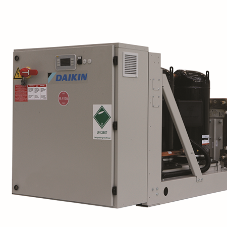Daikin Applied introduce their new generation of air-cooled scroll chillers with R32 refrigerant, a world first.
Product Development Manager James Henley examines the significance of this new launch:
Looking into the background of the refrigerant and efficiency challenges before focusing on the future developments is the key to driving innovation that will meet the tough times ahead. The European Union has set very challenging targets that have been fixed for the coming years.
By 2030, there is a target of 27% increase in energy efficiency and 40% reduction of greenhouse emissions. These two elements should be tackled hand in hand to ensure one is not to the detriment of the other.
The current landscape of the chiller market is evolving, especially with the introduction of Ecodesign Lot 21 for chillers and the refrigerant phase-down targets. End users are becoming a bigger influence in the selection of chillers with concern around the future cost of maintenance.
Daikin Applied is the first in the market to launch a new generation of high efficiency air-cooled scroll chiller series with R32 refrigerant to enhance future installation solutions focusing on both of these key areas. The new range (EWAT-B) will be available for cooling only and heat recovery applications from 80 kW up to 700 kW cooling capacity at nominal conditions.
Exceeding Ecodesign requirements
The range has been delivered to the market with an increase of 10% in seasonal energy efficiency ratio (SEER) compared to the previous R-410A range. The R32 chiller range also fully complies with the efficiency requirements imposed by current European Legislation (Ecodesign Lot21).
Ecodesign Lot 21 requirements are the European benchmark calculation for efficiency, known as SEER, under EN14825. Lot 21 is the critical minimum design efficiency legislation that all chillers will have to meet in order to be sold in the European market. As with all Ecodesign considerations there is a two-tier introduction into the requirements to allow time for design adjustment and technology enhancements. In terms of minimum chiller efficiency targets, the Ecodesign Lot 21 requirements and tier structure are as follows:

SERP Seasonal Energy Performance HT Process Chillers

Reduction in the use of refrigerant
The background for the F-Gas legislation is based on the Global Warming Impact (GWI) of HFCs which will be reduced by phasing down their consumption (in CO2eq = kg x GWP).

To counter direct emissions, F-Gas regulation and targetted CO2 equivalent phase down have been implemented in Europe as per the above schedule. Hydrofluorocarbons (HFCs) do not deplete the ozone layer (ODP = 0). If they are emitted into the atmosphere they have an impact on global warming but if they are contained they have NO impact on global warming; e.g. if they stay inside the equipment and are properly recovered at end of life or during service works.
Example: R410a has a GWP of 2088 this means:
• If 1kg of R410a is emitted into the atmosphere, it has the equivalent impact on global warming as 2088kg of CO2 - compared over a 100-year period.
Global Warming Impact (GWI) is reduced by phasing down the CO2 equivalent consumption of HFCs. The phase-down is not a reduction of quantity of refrigerants available to the market but a change towards a different mix of refrigerants and the introduction of new refrigerants such as R32.
The EWAT-B chiller range utilises R32 refrigerant, minimising the global warming impact of scroll compressor chillers thanks to its low Global Warming Potential (GWP = 675) in combination with high energy efficiency.
The low GWP refrigerant use means that for the same quantity of refrigerant the CO2 equivalent will be significantly less, example based on 430kW Air-cooled chiller:
• R410a (GWP 2088) chiller has 62kg of refrigerant which is 129,456 kg of CO2
• R-32 (GWP 675) chiller has 70kg of refrigerant which is 47,250 kg of CO2
This is a significant potential CO2 saving of 63% if the refrigerant was to leak into the atmosphere. This cannot be ignored and is the reason why low GWP HFO refrigerant is so important to future chiller design.
Daikin has a long history of continually reducing the environmental impact of cooling, heating and refrigeration products, as well as having a unique expertise that comes from manufacturing both refrigerants and equipment. This position is a result of the company’s corporate philosophy to “Be a Company that Leads in Applying Environmentally Friendly Practices”.
Regarding refrigerant choice, Daikin has expertise in using fluorinated (HFC, HFO) as well as non-fluorinated gases (ammonia, carbon dioxide, hydrocarbons), because the company believes in diversity of refrigerant choice to allow the best suited solution to be used in each application.
The new R32 range
The new range will be available for cooling only and heat recovery applications from 80 kW up to 700 kW cooling capacity at nominal conditions, with two efficiency versions (Silver and Gold) and three sound configurations (Standard, Low and Reduced), providing full customisation on the project-specific requirements.
An extensive list of options and accessories can be provided on request, such as the fully integrated hydronic kit for fixed flow or variable flow operation, partial or total heat recovery for sanitary hot water production and many other solutions.
The new series is fully compatible with our remote monitoring system, Daikin on Site, which is a secure cloud-based platform. Daikin on Site offers a number of advanced functionalities including proactive remote monitoring, system optimisation and preventive maintenance and breakdowns.
View Air Cooled Chillers Product Entry






